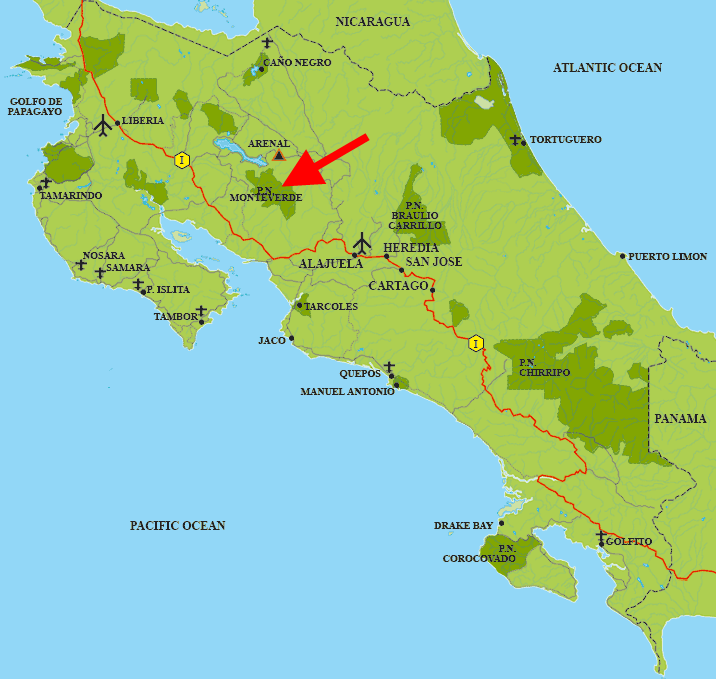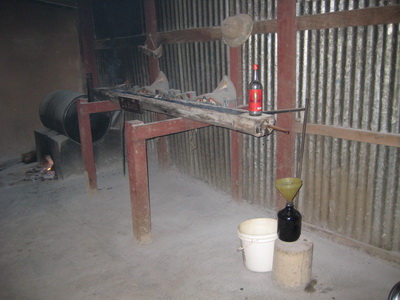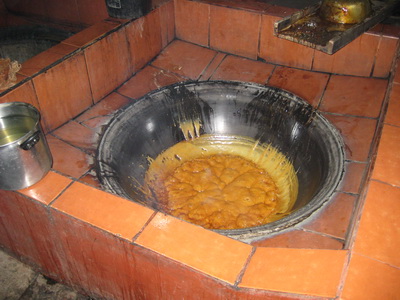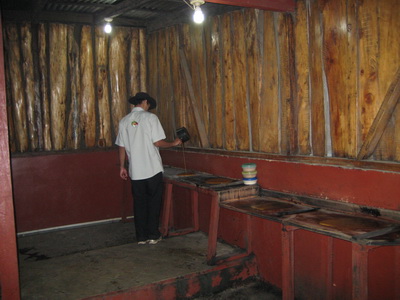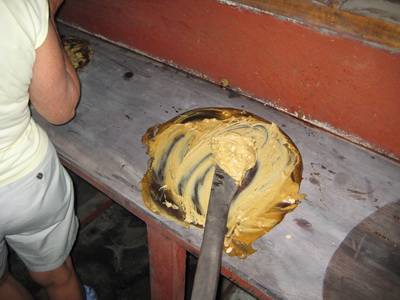|
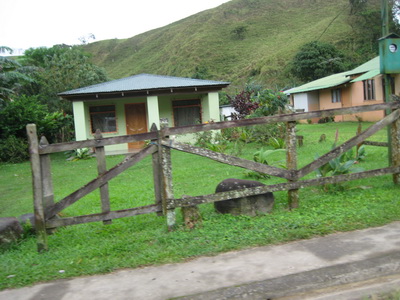 |
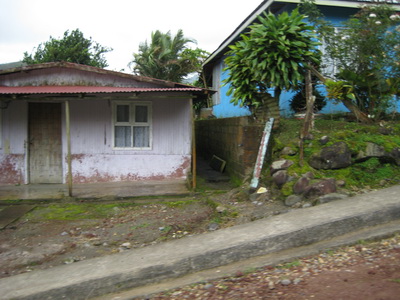 |
|
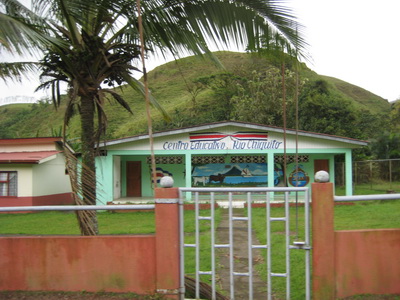 |
|
We are on the move. Short ride in
a van to Laguna Arenal where we board a 35 passenger boat for a 45
minute ride to the other side of the lake. The lake is undeveloped. No
houses, no beaches, no docks. So we walk down muddy paths to get on and
off the boat that is just driven into the bank. I failed to get any
pictures.
Then we take another van ride to
Monteverde. The trip is about 1.5 hours over very very very bumpy dirt
roads but a nice way to see the mountain country and rural villages.
These are some pictures of the way the rural people live. The
picture to the left is a school in a very small village. Education is
top priority for Costa Rica |
|
|
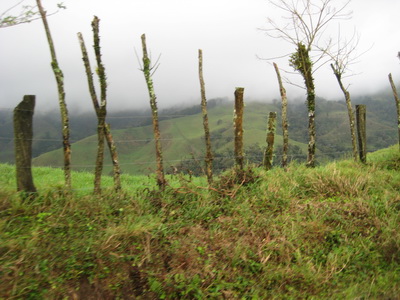 |
|
This is a picture of a living
fence which we saw all over Costa Rica. They have
planted trees where they want a fence then attached
wires to the tree to make a fence. Makes a lot of sense
because the dry rot and termites would destroy any wood
fence quickly. |
|
|
|
|
|
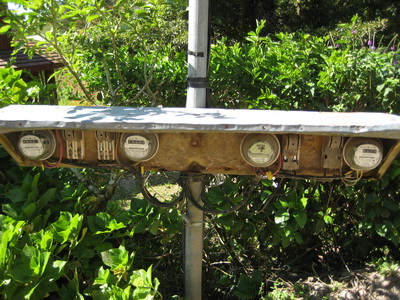 |
|
They have absolutely no
electrical codes in Costa Rica. All of the meters
and wiring are exposed. Once we saw a monkey walking
the wire between poles and everybody was scared that
the monkey might fry if he touched one of the other
exposed wires. (He didn't, at least while we were
watching.) |
|
|
|
|
|
 |
|
Our hotel, El Establo, is on a hill side with a
view of the surrounding mountains. It was established by Quakers in 1946
when they left the US to escape persecution for not wanting to fight in
wars. The hotel is very modern and is half owned by Costa Ricans now but
still shows a lot of the Quaker architectural influence ... simple
furniture, straight back chairs, lots of wood and fancy wood joinery.
We had lunch at the hotel restaurant which was
nicely appointed but very expensive and the food only fair so we won't
be returning.
|
|
|
|
|
|
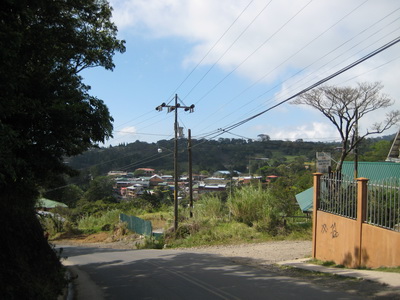 |
|
We then walked the road to town,
about 3/4 mile and explored Monteverde. Notice the paved road. It ended
about 100 yards past our hotel. |
|
|
|
|
|
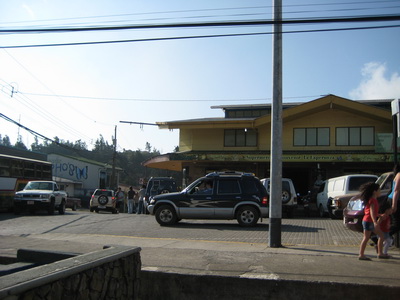 |
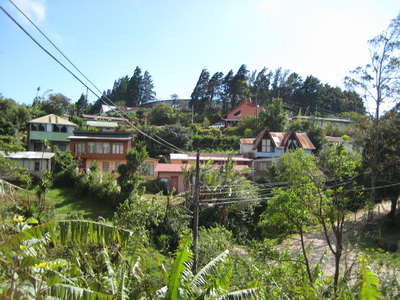 |
|
|
|
|
 |
|
Monteverde is a small town but with a very active
main street. We went into the grocery store to buy supplies for dinner.
They sold wine, beer, vodka and whiskey but curiously no gin or tonic
water. Gin must be hard to get here. I suspect that's why a gin and
tonic cost $10 and a Cosmopolitan only costs $7.
The picture on the left is a very
popular hostel.
|
|
|
|
|
|
 |
|
This is a picture of the sunset
from the balcony of our room. I think I need to work on my camera
exposure skills. |
|
|
|
|
|
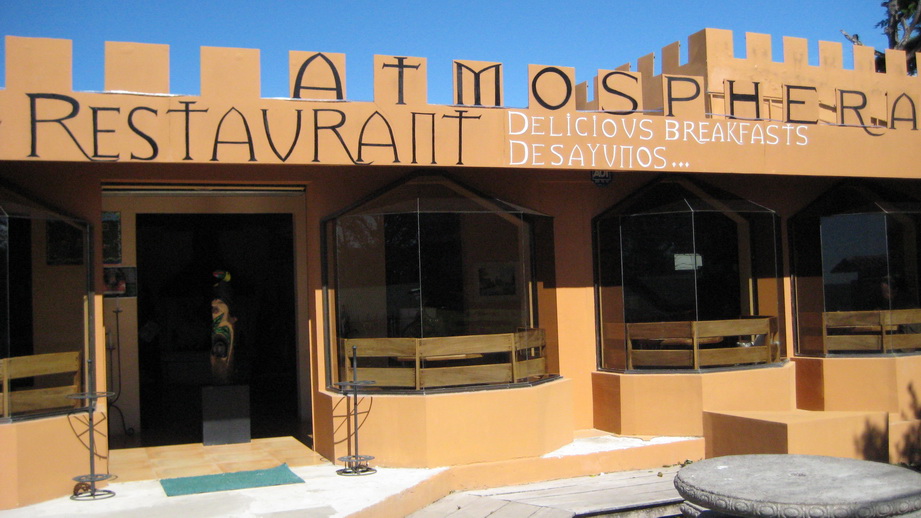
|
|
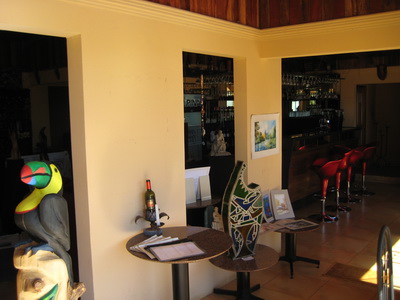 |
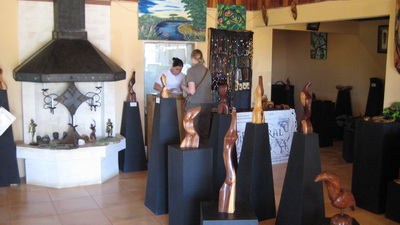 |
|

|
|
Our first tour today was at noon so we slept in.
We walked down the street and found a very stylish place for
breakfast. It was a combo restaurant, bar, internet cafe and art
gallery. I ordered pancakes with fruit. She asked what kind of fruit and
I said bananas. I didn't realize the bananas would be cooked inside the
pancake. They were scrumptious! And so sweet you didn't need syrup.
This is prime coffee growing area but I have yet
to have a good cup of joe or as they say here "jose". Maybe tomorrow, we
can squeeze in a coffee plantation tour with a fresh cup of "jose" at
the end. One refreshing note, I haven't seen a Starbucks anywhere.
Barbara found an original watercolor by the famous
artist Carlos... at the bargain price of 481,100 colonies. Being an
astute world traveler, she bargained the price down to 155,650 colonies.
So breakfast cost me a little more than I had budgeted.
|
|
|
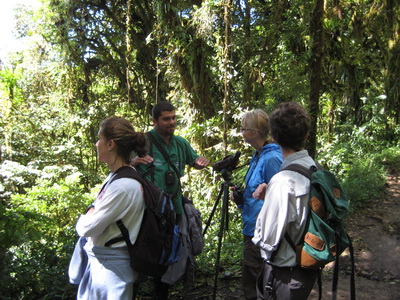 |
|
We took a guided tour of the Monteverde Cloud
Forest Biological Reserve. Do you know the difference between a cloud
forest and a rain forest? Wrong, they are both in the clouds. In the
Cloud Forest it rains more days per year. The rain forest gets more
total rain per year.
There were only 4 people in our group. Noon is the
worst time for a nature hike because all the animals are asleep. But our
guide spotted 2 pit vipers asleep in a tree. And he also spotted a sloth
asleep in a tree. I got a good picture of the sloth (below) asleep in
the tree but you have to use your imagination to pick out his eyes and
nose.
|
|
|
|
|
|
|
 |
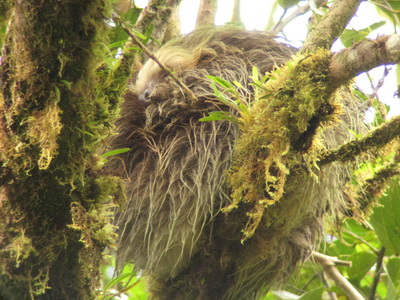 |
|
|
|
|
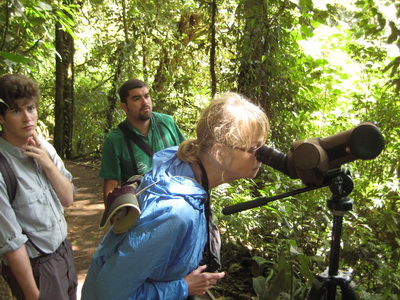 |
 |
|
We also saw a rare Quetzal bird. The Quetzal is Guatemala's
national bird but is extinct there. It only lives in Costa Rica now
and is on the endangered list. Its a large, very colorful bird. We
also saw a Toucan. Kind of disappointed we didn't see more,
especially monkeys.
|
|
 |
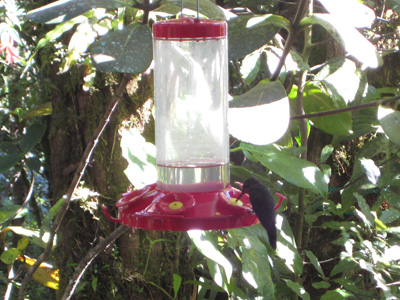 |
|
A large hummingbird. |
|
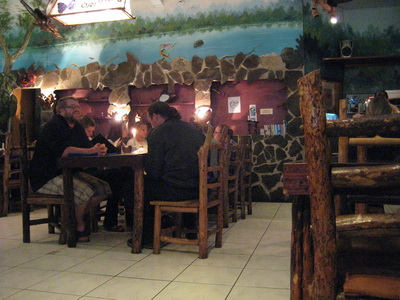 |
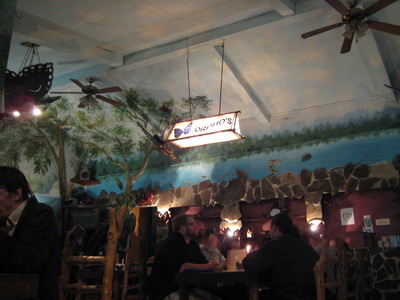 |
|
We walked into town for dinner at a place recommended called
Morpheus. It is a restaurant owned by the son of an immigrant from
the US and seems to cater American style food. We had a
great window view overlooking the downtown metropolis.
|
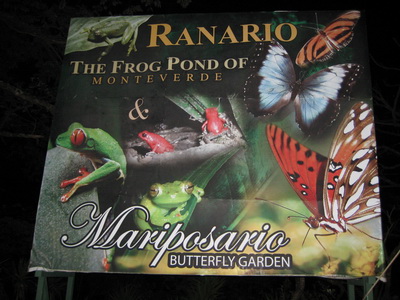 |
| After dinner we walked to a place
called the Frog Pond. They give tours at night when the frogs are most
active. You are lead around by a guide who points out the frogs in
various terrariums with her flash light. Do you know the difference
between a frog and a toad? Answer: If you kiss a frog nothing happens
but if you kiss a toad you have to marry it. Another difference is a
frog has webbed feet and a toad doesn't. You can bet on it. |
|
 |
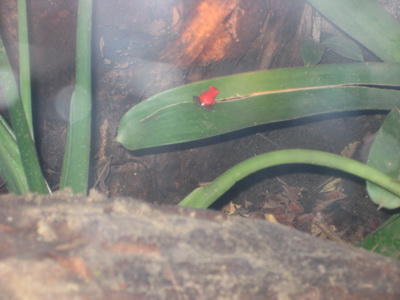 |
|
You weren't allowed to take flash pictures but I took some anyway
because none of my non-flash pictures turned out. |
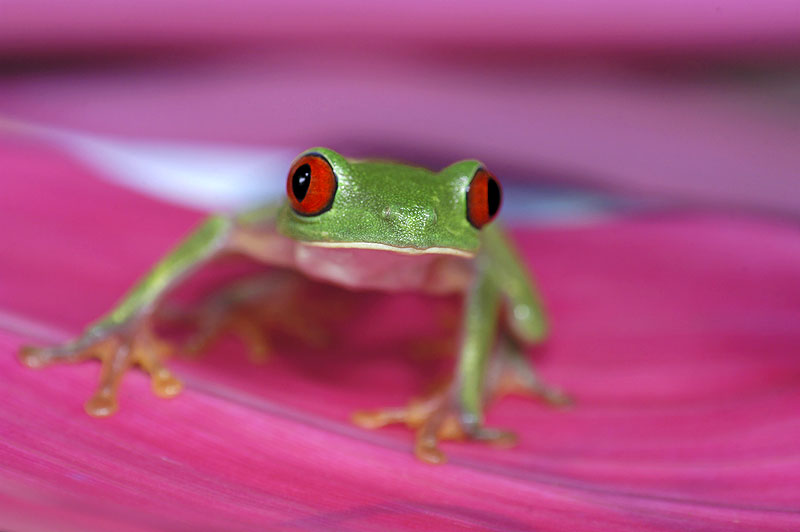 |
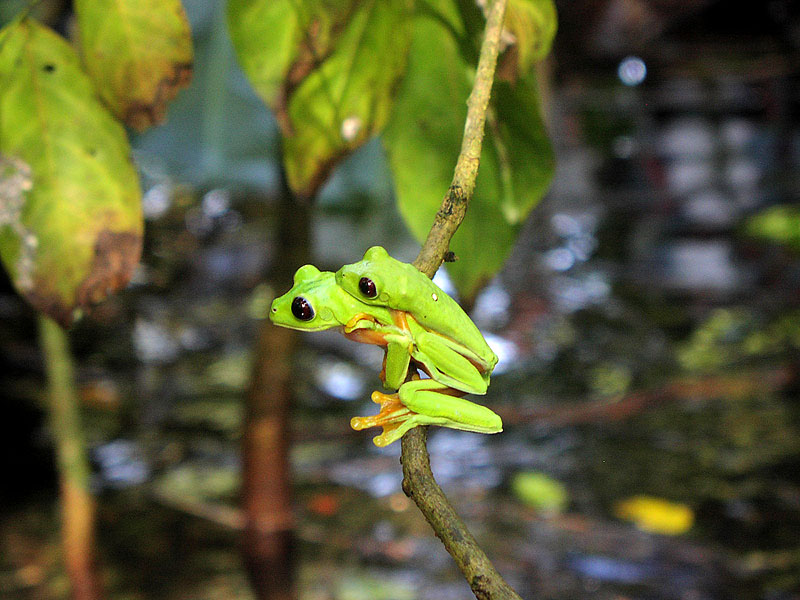 |
 |
|
This morning we got up at 5:00am to go on a 6 hour
bird expedition. We arrived at the designated meeting place, Stella's
Bakery Coffee Shop, just as day light broke. Basically, we walked around
in people's backyards. When our guide spotted a bird he would set up the
telescope and let all 3 of us take a look. Then we would walk to another
spot. This lasted for 6 hours. I don't think I will become a die-hard
bird watcher anytime soon.
But I must admit that it was kind of exciting to
see the endangered, resplendent Quetzal again (picture below). We were
told this was a very rare sighting.
|
|
|
|
|
 |
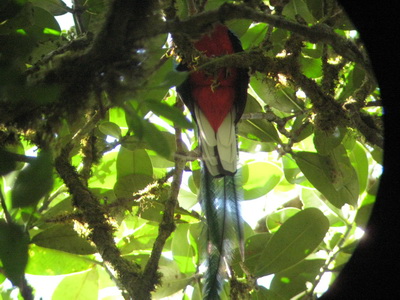 |
|
We saw nine different varieties of hummingbirds. |
The Quetzal were mating and there was 7 birds flying in the area.
It was special to see so many in one area. |
 |
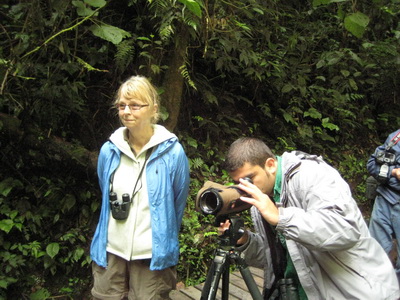 |
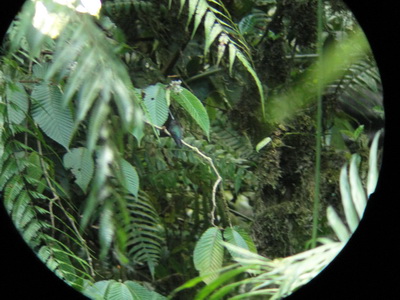 |
|
And we got to see the rare
Green-Fronted Lancebill humming bird. We were told this is also a rare
sighting. But we had already seen umpteen hundred humming birds and they
all looked the same to me. |
|
|
|
|
|
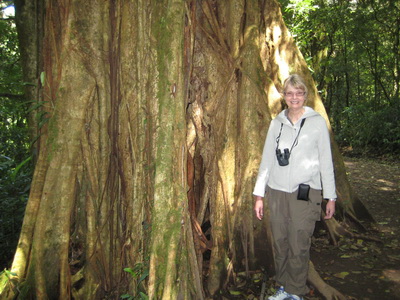 |
|
This is a completely hollow tree
due to the fig tree surrounding the inside tree. The inside tree
dies and leaves the fig tree.
|
|
|
|
|
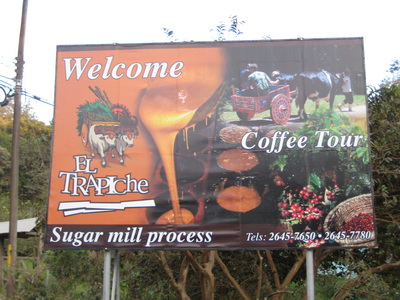 |
| After a short rest, we went on the
El Trapiche coffee plantation tour. It was much more than just coffee.
The tour began with a walk through a family operated farm, where we saw
sugar cane, coffee, bananas, root vegetables, pineapple, oranges, and
plantains being grown. The characteristics of each, especially coffee
and sugar were explained. During the tour the entire coffee and sugar
cane cultivating, harvesting, drying, grinding, peeling, sorting, and
roasting processes were explained and demonstrated. We got to chew raw
sugar cane which was a pleasant experience. |
|
|
|
|
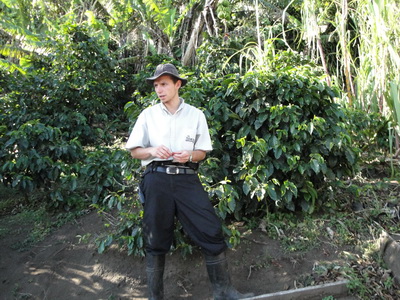 |
 |
| Coffee is still picked by hand
in Costa Rica because no machine could navigate the hills.
Hand picking also results is only good quality beans whereas the
machines shake the hell out of the tree resulting in a lower
quality. It was interesting to learn that most of the pickers are
immigrants from Nicaragua and Guatemala because the Costa Ricans do
not want to do the hard labor. |
 |
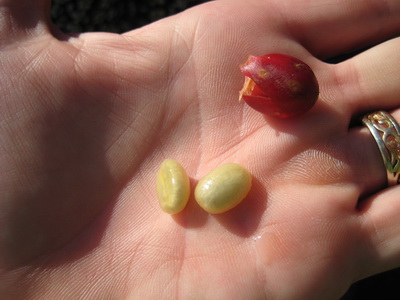 |
|
There are always two beans
inside each coffee berry. Rarely there are three.
|
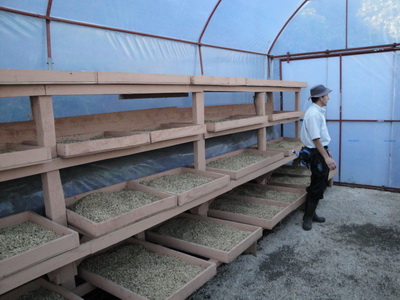 |
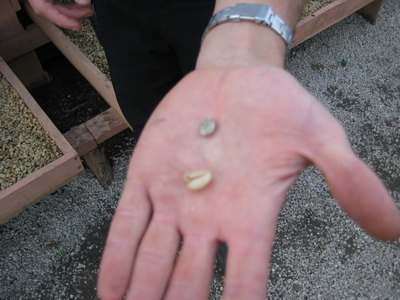 |
|
The beans are dried for
several weeks. Then the husks are removed to reveal the actual
coffee beans
|
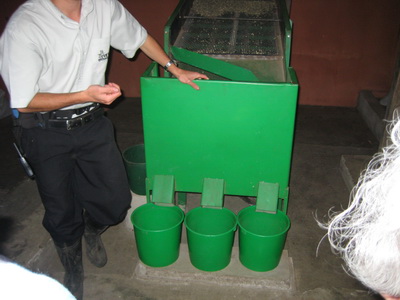 |
| The beans go through several
machines and are finally sorted in this machine. It was
interesting to learn that the best quality beans are rarely sold because
they would be to expensive. Usually a small quantity of the best beans
are mixed with the medium quality beans for export. The poorest
quality beans are sold only to Costa Ricans. My enthusiasm for a
cup of Costa Rican coffee has been deflated. |
|
|
|
|
 |
 |
| We each got a
souvenir bean as it came out of the roaster. |
 |
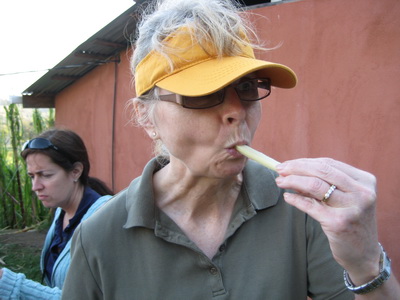 |
| Here we see sugar cane. The
guide is showing how 10 to 12 inch pieces of sugar cane are selected
for planting the next crop. Barbara is enjoying a raw sample of
sugar cane. It was pleasantly good. Harvesting sugar cane is
very dangerous work. Again, it's done by hand because machines won't
navigate the hills. Besides the leaves being razor sharp, the
drying leaves on the ground provide excellent habitation for rats
which attract snakes. |
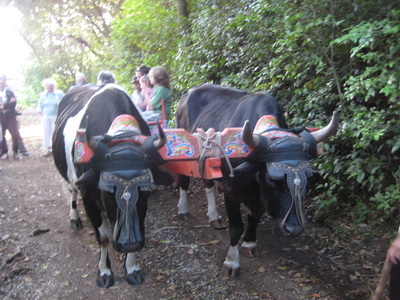 |
 |
 |
|
Several in our group rode on an
Oxen cart as a demonstration of the traditional transportation method in
Costa Rica. Do you know the difference between an ox and a bull? Right,
one has "balls".
The Ox are guided by the pole.
When the pole is standing upright in front of them they stop. When it is
held in the position shown they follow the "driver".
|
|
|
|
|
In the olden days, the Oxen were
also used to turn a press. Here the owner is feeding stocks of sugar
cane into the press and the juice is pouring into the can.
Oxen are still used extensively in
Costa Rica. We saw several on the road during our travels.
|
|
